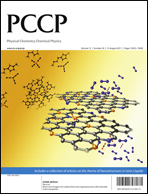Quantum stereodynamics of Li + HF reactive collisions: the role of reactants polarization on the differential cross section†
Abstract
A complete quantum study for the state-to-state Li + HF(v,j,m) → LiF(v′,j′,Ω′) + H reactive collisions has been performed using a wave packet method, for different initial rotational states and helicity states of the reactants. The state-to-state differential cross section has been simulated, and the polarization of products extracted. It is found that the reactivity is enhanced for nearly collinear collisions, which produces a vibrational excitation of HF, needed to overcome the late barrier. It is also found that LiF(v′ = 0) products are preferentially forward scattered, while vibrationally excited LiF(v′ = 1 and 2) are backward scattered. These results are interpreted with a simple reaction mechanism, based on the late character and bent geometry of the transition state, originating from a covalent/ionic crossing, which consists of two steps: the arrival at the transition state and the dissociation. In the first step, in order to get to the saddle point some HF vibrational excitation is required, which favors head-on collisions and therefore low values of m. In the second step a fast dissociation of H atom takes place, which is explained by the ionic Li+F−H character of the bent transition state: the FH− is repulsive making that H depart rapidly leaving a highly rotating LiF molecule. For the higher energy analyzed, where resonances slightly contribute, the orientation and alignment of product rotational states, referred to as reactants frame (with the z-axis parallel to k), are approximately constant with the scattering angle. The alignment is close to −1, showing that j′ is perpendicular to k, while starting from initial states with well defined rotational orientation, as states with pure m values, the final rotational are also oriented. It is also found that when using products frame (with the z′-axis parallel to k′) the rotational alignment and orientation of products varies a lot with the scattering angle just because the z′ axis changes from being parallel to anti-parallel to k when varying from θ = 0 to π.


 Please wait while we load your content...
Please wait while we load your content...